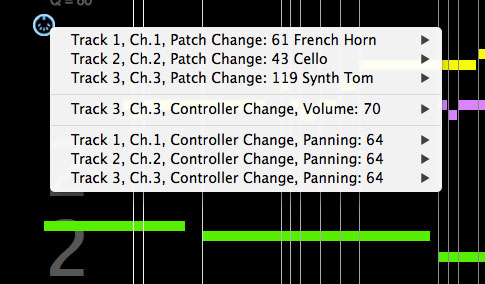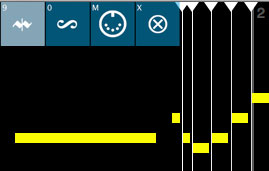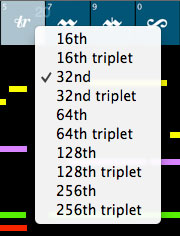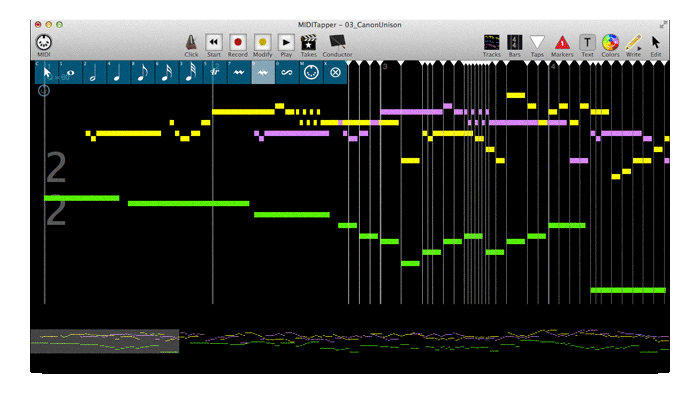



September 30, 2015

Each software I offer starts out as a tool I develop for my own work. I feel this is a good model for my business, because it means I have more of a personal stake in the quality of my software. MIDI Tapper is no exception, and in this beta update, you will find several features implemented because I want these features, not because someone else asked for them, but they are certainly useful for everyone. I have used MIDI Tapper to make recordings of many of my own compositions already. The first large scale work I recorded entirely with MIDI Tapper was 24 Preludes and Fugues for piano, recorded mostly in October 2014 (which also proves that MIDI Tapper has been capable of handling piano music quite well for over a year now).
One of my projects that has been delayed from being recorded is the New Goldberg Variations for pipe organ. Organ music requires some things from MIDI Tapper that piano music does not. The most obvious is multi-timbrality, or different voices being assigned to different patches (timbres). The manuals and the pedals of a real pipe organ do not sound the same. Each manual is assigned its own set of stops, and has its own unique sound. In the MIDI world, this translates into a separate MIDI channel for each division of the organ, with separate "patches" assigned to each channel. This functionality was added two beta cycles ago (beta 49 released in August 2015), and I have been implementing more features related to multitimbrality in the last two releases.

In beta 51, MIDI Tapper is newly equipped to deal with 3 important MIDI channel messages relevant to multitimbrality: patch changes, volume, and panning. These messages are now imported from MIDI files, appear and are editable in the tapping graphical environment, and may be freely added by the user to any MIDI Tapper file. The messages are displayed with a small MIDI DIN icon, as shown at right.
When one of these icons is clicked, a popup menu appears showing all of the MIDI messages it contains.

The ability to add and edit these messages tied in with several other features I had intended to add since the inception of the project — namely, note duration editing and ornamentation. In Write mode (selected by the pencil tool) the display now shows a small toolbar at the top left.

Now when adding notes, durations may be selected, which are proportional to whichever measure the note is being added to. This is simple enough. A more unusual feature is the addition of ornaments. Below is shown a portion of an imported MIDI file.

When the mordent tool is selected, and the first yellow note is clicked, a mordent is added, as shown below.

All ornaments are "intelligent" in selecting which notes above or below to use in the ornament. MIDI Tapper looks at the context within which the ornament is added, analyzing the pitch content surrounding the note to be ornamented. Based on what it finds there, either wholesteps or halfsteps above or below are selected. If no adequate context can be found, MIDI Tapper looks at the imported MIDI file for a key message (what key the piece is in) and if it exists, bases its choices of step sizes on that.
Ornaments vary in their rhythmic structure, and the user should be able to select the duration which is used for the ornament; for example, a short trill is often executed as a 32nd note triplet (that is, 1/48th of a whole note duration) while a turn is often executed in 16th notes. In MIDI Tapper, ornament durations are selected by menu activated by right-clicking on any of the ornament tools.

With multitimbral support and ornamental functions in place, MIDI Tapper is now ready to record projects like the New Goldberg Variations, and I hope to have a recording completed soon.
One feature that was added by request was additional display color options for notes. Now in addition to color by channel and color by velocity, the notes can also be colored by MIDI note (12ET) chromatically, or by position in a 12ET circle of fifths. The possible note color options are shown in sequence in the image below.

The full list of update details is as follows.
If you already have a beta license, this new version is a free download from the MIDI Tapper software page. If you would like to join the beta testing team, just purchase a 30-day license (it's only $2.99).
Regards,
Aaron
[ Showing 1 entry | Previous entry | Next entry | Show all entries ]